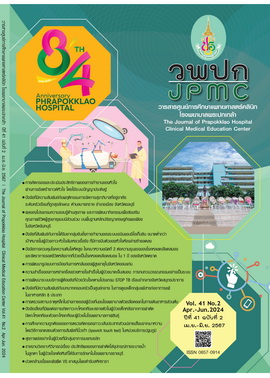Factors Related to Family as Centered Role of Caring Group of Children Allergic to Major Food Allergens
Main Article Content
Abstract
BACKGROUND: A food allergy is a particular immunological reaction of the body to certain proteins in food the occurs by producing antibodies. It was shown that the age group with the highest prevalence of allergies was youngsters between the ages of 5 and 12. Seafood, dairy products, eggs and wheat flour were the food groups that triggered the greatest allergic reactions. In providing care for newborns with food allergies, the family is crucial.
OBJECTIVES: To study the healthcare behaviors of children with food allergies and the top eight allergies of the family. Factors that correlate with the role of family-centered care in the care of children with food allergies in the top eight allergens group are: Perceived severity of food allergies, perception of the risk of food allergies, recognizing the duration of illness, elements of a mobile application and the role of the family in care. The top eight allergies need to be identified and properly treated.
METHODS: This study uses a cross-sectional design to examine variables related to the role of the family in providing for children with the eight major food allergens. One hundred families with children who had food allergies made up the sample group. The researcher developed a questionnaire to gather data, which included the following topics: components of mobile applications, risk perception of illness duration, perceived severity of food allergies and the role of families in providing care for children with food allergies. Included in the questionnaire were the eight main types of food allergies, as based on health belief patterns.
RESULTS: The average score of caregiver perceptions of the risk of food allergies was found to be high (X̄=21.7), while the perceptions of the caregivers on the severity and duration of food allergies were found to be moderate (X̄=17.0). A high level of a variety of mobile application elements (X̄=14.8), a moderate level of illness (X̄=5.7) and a high level of the role of families with children with food allergies (X̄=82.6) were observed. The predictive elements correlation analysis results are related to the role of families whose children have severe food allergies. Out of all the categories, mobile application components have the strongest correlation (r=0.50), while all four characteristics might predict how a family will handle food-allergic children (27.4 percent of the time).
CONCLUSIONS: The findings of this study offer guidance on the care of children with food allergies in the family. Public health professionals ought to inform teachers, school nurses, families and communities regarding the severity of food allergies and the length of each type of allergy. There are mobile applications that provide first aid and dietary recommendations.
Article Details

This work is licensed under a Creative Commons Attribution-NonCommercial-NoDerivatives 4.0 International License.
References
Bird JA, Lack G, Perry TT. Clinical management of food allergy. J Allergy Clin Immunol Pract 2015;3:1-11.
Alruwaili YS, Hammad SM, Elwan A. Prevalence of allergic rhinitis among female secondary school students, in Arar city, Saudi Arabia. Med Sci 2021;25:363-73
Mahdavinia M. Food allergy in adults: presentations, evaluation, and treatment. Med Clin North Am 2020;104:145-55.
Mahmoud MH, Wahb HMA, Mahmoud MH. Evaluation of a new baby food prepared from Opuntiaficusindica fruit in Wistar rats with either calcium deficient or vitamin A depletion. JAPER 2019;9:101-8.
Patel N, Herbert L, Green TD. The emotional, social, and financial burden of food allergies on children and their families. Allergy Asthma Proc 2017;38:88-91.
Meyer R. Nutritional disorders resulting from food allergy in children. Pediatr Allergy Immunol 2018;29:689-704.
Loh W, Tang MLK. The epidemiology of food allergy in the global context. Int J Environ Res Public Health [Internet]. 2018 [cited 2022 Oct 10];15(9):2043. Available from: https://www.ncbi.nlm.nih.gov/pmc/articles/PMC6163515/pdf/ijerph-15-02043.pdf
Sampath V, Sindher SB, Alvarez Pinzon AM, Nadeau KC. Can food allergy be cured? what are the future prospects?. Allergy 2020;75:1316-26.
Nookong A. Food allergies in children: more dangerous than you think [Internet]. 2023 [cited 2023 Nov 17]. Available from: https://www.nstda.or.th/sci2pub/food-allergies-in-children/
Mookachonpan D. Regulations of food allergies. For Quality Journal 2009;114:69-71.
Lao-araya M, Trakultivakorn M. Prevalence of food allergy among preschool children in northern Thailand. PediatrInt 2012;54:238-43.
Janz NK, Becker MH. The health belief model: a decade later. Health Educ Q 1984;11:1-47.
Jongudomkarn D. Family health nursing: theoretical concepts and application in times of family crisis. 4th ed.KhonKaen: Faculty of Nursing, KhonKaen University; 2021.
Suratanont N. Food allergy management in child care center and school: practical guidelines. In: Suphapeetiporn K, Chongsrisawat V, Deekajorndech T, Chatrproedprai S, Sosothikul D, Rianthavorn P, et al, editors. Interprofessional Team Care in Pediatrics: Learn and Work Together. Bangkok: Chulalongkorn University; 2021. p.14-21.
Faul F, Erdfelder E, Lang AG, Buchner A. G*Power 3: a flexible statistical power analysis program for the social, behavioral, and biomedical sciences. Behav Res Methods 2007;39:175-91.
Keller SP, Kelvin EA. Munro’s statistical methods for health care research. 6th ed. Philadelphia: Lippincott Williams & Wilkins; 2013.
Sriratanaban J, Witvorapong N, Woratanarat T, Ngamkiatphaisan S, Wimuttichai V, O-charot L, et al. The preparedness and responses of the health services system to the COVID-19 crisis in Thailand: hospital operation and economic and social impacts within the boundary of the health services system [Internet]. 2021 [cited2022 Oct 10]. Available from: https://kb.hsri.or.th/dspace/handle/11228/5391
Pichaitum S. The association between family factors and parenting style and nutrional status among grade4-6 students in schools under the office of the basic education commission in Muang district [dissertation]. Phitsanulok: Naresuan University; 2019.
Yamcharoen J, Tangsatjatam P. Family Relationship Support Application by using Mobile and Social Network Technology. In: Proceedings of the7thAcademic Science and Technology Conference; 2019 Jun 7; PathumThani, Thailand. p.1646-58.
Leaungsomnapa Y, Samroumram P, Pimtara P, Micor T, Prasong D, Klangjai T, et al. The effectiveness of using mobile application improving the perception of dopamine drug administration skill among nursing students. J Prapokklao Hosp Clin Med Educat Center 2020;37:134-43.

